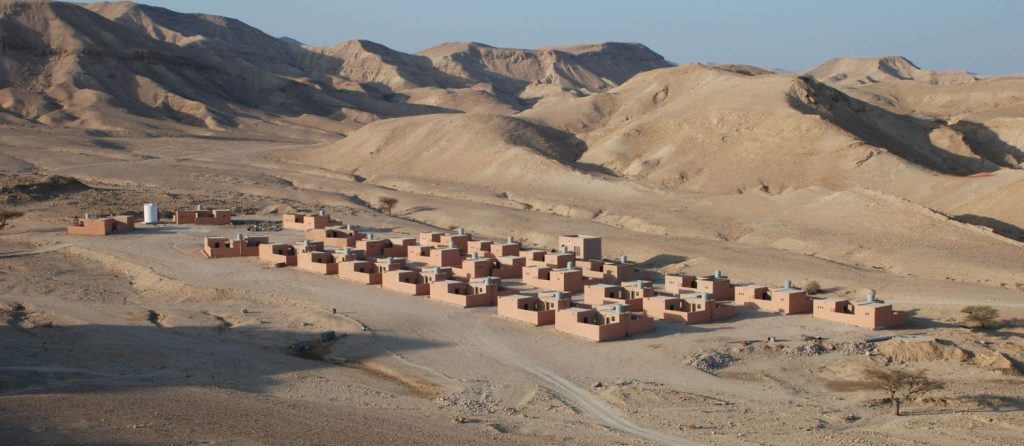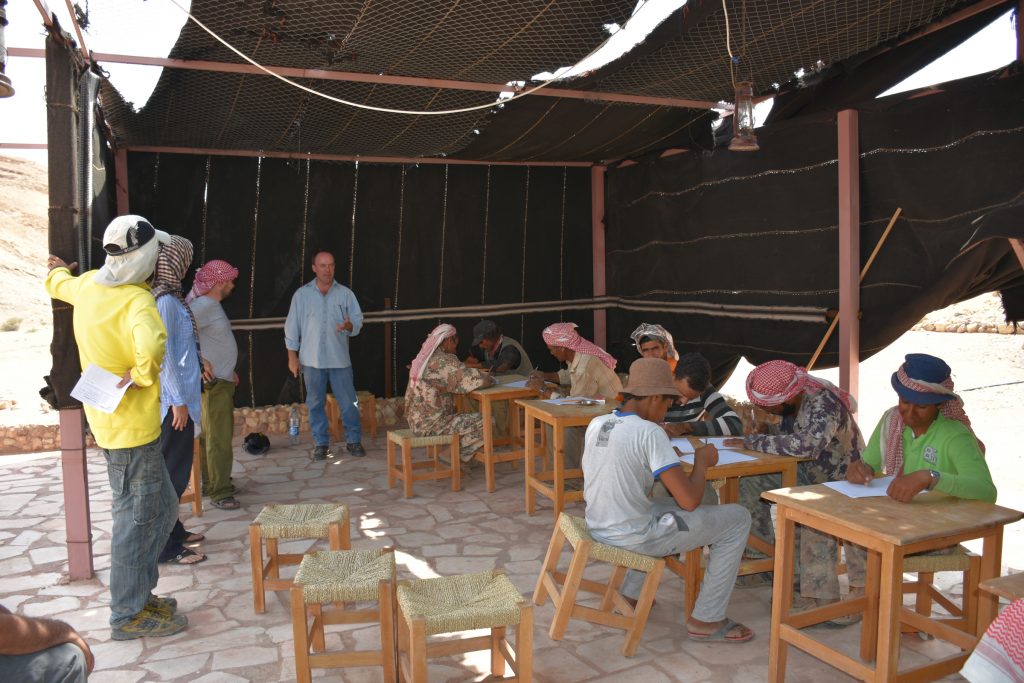
Archaeologist and recent ACOR-CAORC Fellow Andrew M. Smith II writes below about his ongoing research at the important Nabataean-Roman site of Bir Madhkur in Jordan’s Wadi Araba and how USAID SCHEP has been supporting efforts to increase awareness of the site’s important remains.
During my recent fellowship at ACOR, I was pursuing two interrelated and mutually supporting projects that both consider the integration of the city of Petra with its hinterland, whether in antiquity or today. The focal point is the distant settlement of Bir Madhkur, a major waystation along the ancient Incense Route, 12 kilometers northwest of Petra in the foothills of Wadi Araba, Jordan.

On the one hand, I am finalizing the manuscript for a book that will examine the rural economy of Petra in classical and late antiquity, and archaeological data from the Bir Madhkur Project will be a key component of that publication. On the other hand, during my recent fellowship at ACOR I was also directing the Bir Madhkur Incense Route Project, a USAID SCHEP funded project.
What social and economic relationships existed in the past and what exists today between Petra’s urban and rural landscapes and how might these be mapped to understand processes of community development either toward stagnate or more prosperous outcomes? Responding to this question requires an assessment of the cultural heritage significance of Petra’s distant hinterland, which we attempted based on information gained from various stakeholders, local and non-local.

The complete history of Bir Madhkur is not known, but the site was clearly occupied in the Nabataean, Roman, Byzantine, and perhaps early Islamic periods. Major, extant features of the ancient settlement include a fourth-century A.D. Roman fort, a civilian settlement west of the fort, a bath complex, cemeteries, and numerous other structures in outlying areas. Regionally, Bir Madhkur lies in an area of rich–yet virtually unexplored–cultural resources, which includes several sites associated with the ancient trade in frankincense and myrrh. All of these sites lie in the hinterland of Petra, in the central Wadi Araba, which is now the target of intensive economic development that threatens the archaeological landscape. The area also has a rich prehistory, but mostly undocumented.
Assessing the cultural heritage significance of Bir Madhkur in the hinterland of Petra requires taking a holistic approach to the landscape. The cultural landscape of Bir Madhkur, for example, is more than an inventory of ancient or relevant archaeological “sites” of varying types; it is a web of cultural and environmental interactions, the historic, cultural, and natural landscapes intertwined. Together they narrate a story about shared heritage. Also, assessing cultural heritage significance is about articulating and ordering the values (e.g., historical, scientific, aesthetic, natural, and social) that may be identified in relation to these landscapes, in a way that is clearly understood by the local community, visitors to the area, and government agencies responsible for these landscapes. Moreover, ascribing value is a subjective matter, as much depends on the perspectives and the priorities of different individuals and groups. Even among the various stakeholders, assessments of value rarely conform. The recognition is that heritage is constructed in the hearts and minds of people; it is a cultural construct that is socially grounded. The cultural landscape itself is a landscape of memory, the significance of which is tied not only to the past, but also to the present and the future. Therefore, in terms of defining the cultural heritage significance of Bir Madhkur and its territory, varying viewpoints must be collected from the different stakeholders and then merged until a shared definition is reached.

Recognizing cultural heritage significance is one thing; using that information in productive ways is quite another. At Bir Madhkur and regionally, the central issue is poverty. The communities in Wadi Araba are the most impoverished in Jordan, so the past tends to have less relevance to the here and now. Income is sorely needed, and the element of immediacy is palpable. A related issue is the notion of preservation of cultural heritage assets, which seems to be less of a concern to most stakeholders. In terms of the local community, for example, why preserve remnants of past, more ancient communities whose histories are not always active in the daily memories of those occupying the same space today? While there is generally a passive recognition, the immediacy of meeting daily needs has a tendency to suppress the significance of these cultural heritage assets. In some respects, cultural heritage in rural contexts tends to be viewed as a limited resource for future development; it is either overlooked or viewed as an obstacle to other, more promising development schemes. Another option would be to loot the resource with the hope of gaining some immediate reward, however minimal that reward may be. This reflects a general disregard for the cultural resource in the first place; it is also a commentary on the regional poverty.
SUPPORT THE ACOR FELLOWSHIP PROGRAM – Donate to the ACOR Annual Fund
ACOR is proud of the innovative scholarship that the ACOR fellowship program supports. Help ensure that future scholars will be able to enjoy the support of ACOR in Jordan by donating to the ACOR Annual Fund today.
Impoverished communities tend to put pressure on governments for assistance, so governmental stakeholders often walk a precarious line between preservation and non-preservation for the sake of development that virtually mutes the issue of cultural significance altogether. A third issue seems applicable here: the need for more positive changes to poor living conditions in a timelier manner. This requires, above all, communication between the various stakeholders, greater community awareness and education, and more creative solutions that merge past and present towards a more productive, sustainable future. The Bir Madhkur Incense Route Project was designed largely to address this third issue.

In the end, what I have gleaned most from all of this work are the many ways in which the past informs the present. For example, as mentioned, my work at Bir Madhkur began years ago to examine the rural economy of Petra in classical and late antiquity. One aspect of this work is to understand Diocletian’s many responses to the economic crisis that affected the entire Roman world in the third century A.D., one of which was to construct the military base at Bir Madhkur. He also took steps to revive the agricultural landscape, which is a very similar response to that of the Jordan Valley Authority today after being faced with similar economic conditions. Examining the archaeological footprint of Diocletian’s measures is one thing, but trying to understand the social processes is another. In this sense, I benefited from the experience of being embedded in the Bedouin community of Bir Madhkur, where I have been able to explore different evaluations of the significance (or insignificance) of cultural heritage assets in the region in relation to local conditions and attitudes, especially in relation to their poverty and the expectations they have of outside assistance. This is not to say that the same attitudes existed in antiquity when the region was just as impoverished. Nevertheless, between past and present, perhaps there are more similarities than differences in terms of the social, economic, and cultural relationships people have with the landscapes in which and with which they interact.
Andrew M.Smith II is an Associate Professor of History and Classics at the George Washington University who specializes in the social and cultural history of the Greek and Roman Near East. Currently, he directs the excavations and survey of the Roman fort at Bir Madhkur (as part of his larger Bir Madhkur Project), a site that also served as the first major caravan stop west of Petra on the ancient Incense Route.
